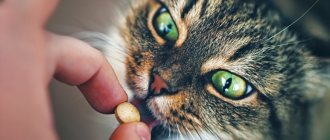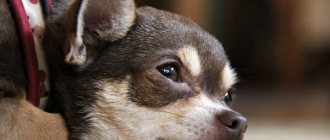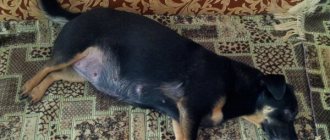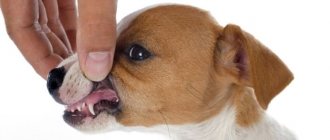Childbirth at home
It is preferable for the birth to take place at home. The birth process lasts several hours and all this time the animal must be supervised in a comfortable environment. Strangers and unfamiliar premises can frighten the female and provoke complications.
The mother and future puppies will need a secluded nest, protected from external influences . It is better to prepare it 5-6 days before birth, so that the animal has time to get used to it. A spacious box or drawer lined with a thick mattress and replaceable absorbent diapers is suitable for it.
For birth at home, you will need an additional box for newborn Chihuahua puppies, cotton diapers, brilliant green, threads for tying the umbilical cord, a heating pad and several pairs of sterile medical gloves to avoid infection of the animal (since small breeds of dogs have rather weak attempts, it is highly likely that help the pet manually).
Recording contractions
The body prepares for childbirth by contracting the muscles of the uterus, that is, contractions. As a result, the cervix gradually opens. This process is painful, so it can be determined by behavior. The dog becomes restless, breathes heavily and frequently, and rummages in the nest.
It is also very important to take into account physiological signs - the gradual lowering of the tummy. If your Chihuahua is pregnant and giving birth for the first time, then not everything is so obvious. The drooping of the abdomen may be barely noticeable, so be extremely careful. During contractions, you can see how the dog’s sides tense up and the characteristic pits on them. This usually lasts from an hour to a day.
As soon as you notice your dog's contractions, start recording the time. Afterwards, barely noticeable attempts begin. They gradually intensify, and the interval between them is about forty minutes. The process can take up to five hours after the first attempts. If after this period puppies do not begin to appear, then immediately contact your veterinarian. Your pet may not be able to cope with natural birth. In this case, the specialist will be forced to perform a caesarean section. Of course, you shouldn’t carry out such an operation yourself at home.
How many puppies does a Chihuahua give birth to?
The number of embryos depends on the age of the bitch and maternity experience. On average, Chihuahua dogs bear 2-4 puppies. Young, especially primiparous, and older females usually have 1-2 puppies in their litter. At the same time, their pregnancy lasts 3-4 days longer, and the weight and size of the newborn offspring is greater.
The number of puppies is affected by the weight of the Chihuahua. If there is underweight, the number of puppies is usually also small (1 or 2).
Pregnancy
Experienced dog handlers recommend mating Chihuas between the ages of 1.5 and 8 years. There must be an interval of 10-12 months between births, during which the female’s body recovers.
There are several ways to make sure that an animal is bearing offspring:
- Laboratory blood test (3 weeks after mating). It is used to determine the presence of relaxin in the bitch’s blood. This hormone confirms her interesting position. Accuracy 99%.
- Ultrasound (after 4.5 weeks). Accuracy 100%. An examination on day 40 will show the number of puppies in the litter.
- Temperature measurement (1 day before birth). A pregnant dog's body temperature is 38-39℃. Before the start of whelping, it drops sharply to 36℃ and is restored to normal levels after the babies appear.
Terms and signs
Long-term practice shows that on average, Chihuahua pregnancy lasts from 58 to 64 days. If labor begins earlier, it means a large litter is expected. An extended reproductive cycle indicates a small number of newborns.
The first signs of an interesting situation:
- poor appetite;
- decreased activity, lethargy, apathy;
- clumsy gait.
About a month after mating, the belly begins to grow. After the 3rd week, the owner can carefully palpate the belly to determine the number of future babies.
Stages of an interesting situation
A pregnancy calendar, scheduled day by day, helps Chihuahua owners navigate the condition of their ward.
| Duration, days | Symptoms and Behaviors |
| Up to 23 | Thirst, drowsiness. There is almost no weight gain. Daily routine is normal |
| From 21 to 28 | Change in hormonal levels. Capricious behavior, refusal of usual food |
| From 24 to 35 | Carrying out an ultrasound. Transition to 3 meals a day. After the first month, they begin to add bone meal, tetravit and vitamins to the food |
| From 38 to 45 | Carrying out USG (ultrasonography). Feed a pregnant Chihuahua special types of food |
| C 42 | Avoid sudden movements and overwork. Reduce walking time. Handle the animal more often on the street |
| From 48 to 50 | Possible loss of appetite. Transition to 4 meals a day. Diet change: fish completely replaces meat. Excluding tendons and bones from the menu |
| After 50 | Beginning of lactation. In firstborns, milk may appear immediately before whelping. For experienced bitches - on day 40 |
| The day before giving birth | Sudden drop in temperature (36℃) |
What to do if the pregnancy is false?
Sometimes, due to hormonal imbalance or psychological trauma, a Chihuahua develops a false pregnancy. It is observed after mating without fertilization or during estrus without mating.
Veterinarians cite the following as the main reasons for the appearance of an unstable condition in a dog:
- unsystematic mating;
- excess levels of the hormone relaxin in the body;
- disorders of reproductive functions, diseases of the fertilization organs.
Signs of a fake pregnancy appear 2 months after the end of the last estrus. The dog becomes nervous, its appetite worsens and apathy appears. She walks slowly. The enlargement of the mammary glands and abdomen is visually noticeable. A false pregnancy ends with false contractions.
An unstable condition is dangerous to the health of the animal, so owners should immediately contact a veterinarian.
What you need to know about childbirth?
Normally, labor begins 1-3 hours after the release of amniotic fluid. Contractions become more frequent, and by the time of birth the interval between them is reduced to 5 minutes. If the course is favorable, after 20 minutes - 1 hour a water bladder appears, which, as a result of pushing, bursts and then the amniotic sac with the first-born comes out. The fetus comes out head first, while the puppy remains alone and the amniotic sac is not damaged.
If labor does not begin 1-2 hours after the water breaks, or labor lasts more than 5-6 hours, you must call a veterinarian.
The structural features of the body of Chihuahua puppies, namely the large size of the head, coupled with the narrow birth canal in females of this breed, often become the cause of protracted, difficult labor. A common complication for the breed is also breech placement of the fetus, in which the puppy is born with its hind legs forward. Moreover, if the puppy is large, an urgent caesarean section will be required. In this case, you should discuss the possibility of an emergency visit with your veterinarian in advance.
After each puppy, the placenta is removed. The dog will probably try to eat it. This is a normal process; the tissues of the placenta contain a hormone that provokes the secretion of milk for feeding puppies.
Childbirth process
Dog owners often wonder: when does a Chihuahua begin to give birth, what do you need to know to properly adopt it? And this is a competent approach to business. In order not to harm your pet, you need to understand how everything happens naturally, without human intervention.
When intense contractions begin, the fetus moves into the birth canal. At this time, the dog lies on its side and, if possible, rests its paws and back against the walls of the box. In this position, it will be easier for the Chihuahua to bear all the hardships. Some dogs find it easier to do this in a standing position. Labor itself begins when the amniotic fluid breaks. The bubble usually ruptures on its own, or the dog does it. The water flows out to wash the birth canal and facilitate the further release of the fetus. It is absolutely forbidden to pierce the bubble yourself.
The contractions are already taking longer and getting stronger. The dog is gathering strength so that the puppies will be born. At this moment, it is better to be close to your pet in order to help and facilitate childbirth for the Chihuahua if necessary. How long can the pain last before the first puppy arrives? Typically this process takes no more than five hours.
Behavior before childbirth
With consistent pregnancy monitoring, predicting the due date is easy. The duration of pregnancy in dogs varies from 58 to 65 days. The duration of gestation depends on the number of embryos and their size: the fewer puppies in the litter, the larger they are and the more time it takes for the fetus to develop.
Everything necessary for labor should be prepared by days 54-56. From this time on, you should look after your pet with increased attention:
- 2-3 days before the onset of labor, the dog becomes sensitive to cold and drafts , which is caused by a decrease in its own body temperature by 1-2 °C in anticipation of the onset of labor; in small breeds, such as Chihuahuas, chills and severe trembling may be observed;
- when childbirth approaches, the dog begins to show increased anxiety , rushes about and whines, a drooping belly causes discomfort and inconvenience;
- within 6-12 hours the animal refuses to eat;
- During the same time period, the bitch is trying to build a nest for childbirth , looking for a secluded place, digging the floor, looking for a soft place protected from drafts.
Main features
Four weeks before giving birth, the Chihuahua's belly expands. Within three weeks, the pet’s genitals begin to swell and a clear discharge may appear. Ten days before an important event, the mammary glands enlarge. In some individuals, droplets of milk may appear from the nipples.
When a dog begins to feel contractions approaching, its behavior changes dramatically. The first clear sign of future birth will be the nervous state of the Chihuahua. She begins to rush from side to side, digging the floor with her paws. The pet begins to tremble, breathes quickly, and the heartbeat increases sharply.
Depending on individual characteristics, the dog may look for a corner where there is no light in order to hide from everyone, or vice versa - not leave the owner, constantly caressing him. They also have different attitudes towards food - some pets before giving birth eat as much as you can offer, while others refuse food.
The Chihuahua's anxiety is explained by a sharp increase in the abdominal cavity. This is caused by small but painful contractions. The dog's belly begins to slowly drop down. If this is the pet’s first time, then the lowering of the tummy is not particularly noticeable - there are no characteristic pits on the sides.
First birth
Before the first mating of a Chihuahua, you need to make sure that the bitch is “prepared” for childbirth; you should plan your pet’s first pregnancy no earlier than 1.5 years of age. The constitution of the dog must be taken into account. Miniature individuals are dangerous to use for breeding.
The first birth in dogs of small breeds is often associated with complications; a special risk group includes dogs of the Chihuahua breed, whose weight does not exceed 1800 grams, since during the birth process they may not experience labor at all (no contractions) and there is a high probability of fainting as a result overvoltage.
Due to the shortness of pregnancy during the first pregnancy, the offspring are quite large, which makes it difficult for the fetus to pass through the narrow birth canal. In such a situation, the owner must be prepared to provide proper obstetric care.
If the breeder does not have experience in helping an animal during childbirth, it is advisable to enlist the support and assistance of more experienced dog breeders during the first pregnancy or resort to the services of a professional obstetrician specializing in miniature breeds. It is also useful to watch videos and tips from experienced owners.
Problems and their solutions
There are problematic situations when urgent veterinary care is required:
- The puppy got its head stuck in the pelvic bones.
- Problem contractions are very weak, they cannot push the fetus through.
- The contractions suddenly stopped.
- There is heavy bleeding or a high fever.
- One day after the birth of the last puppy, black-green discharge occurs.
- Cramps after childbirth.
All these are complications that oblige the owner to one single help - calling a veterinarian. Only he can quickly figure out the problem and solve it correctly. Or, based on his clear instructions, the owner will be able to help while the doctor is on the way.
Pathological childbirth is a consequence of congenital problems in the dog’s body. The most common anomalies:
- Narrow birth canal – a Chihuahua puppy with a bladder cannot pass. If the fetus is small, there is a chance of natural birth. But in case of large fetus, a caesarean section must be performed.
- Incorrectly positioned fetuses are the main cause of birth complications. If the cervix has not been able to open fully, the pelvis is narrow, the fetus is dead or too large in the womb, a caesarean section cannot be avoided.
- Very weak contractions, a large gap between them. Caused by hormonal disorders, obesity, inflammatory processes. Indication: drug induction of labor by a veterinarian.
How to deliver a baby to a dog?
During the entire day of birth, it is necessary to stay close to the pet, since the first contractions can frighten her, especially if the female is whelping for the first time. For convenience when assisting the animal and the comfort of the dog, it is possible to place the woman in labor directly on her lap, laying down a disposable diaper.
In this case, the owner will be constrained in his movements, since during the birth process the bitch can no longer be moved from his knees. In addition, some females prefer to find support with their backs and front paws to increase resistance during contractions. Therefore, it is more advisable to place the animal in a prepared “nest”, having first removed the roof from it.
If the contractions are intense enough and the uterus is well dilated, the first puppy will appear 10-15 minutes after the rupture of the water bladder. It will need to be freed from the amniotic sac and intensively wiped with a gauze cloth in the direction against the hair (from back to head) to provoke the respiratory reflex. Then, after the placenta appears, the umbilical cord must be cut at a distance of 2-3 cm from the puppy’s tummy and tied with thread.
If the attempts are weak and the bitch cannot cope, which is common among small breed dogs, obstetrics should be started. During the next contraction, the fetus must be secured in the birth canal, preventing retraction. To do this, secure the loop area with your fingers. Be sure to use medical gloves.
If there are signs of pelvic adherence, try to assess the criticality of the situation. If the newborn is calm and the amniotic sac is not damaged, then with the next attempts, slightly pull the bladder in the direction of the birth canal, helping it move outward. Then proceed as usual.
If the puppy does not pass into the birth canal and twitches intensely, this indicates oxygen starvation. Without waiting for the next contractions, gently pull the baby by the paws, and then by the skin at the withers. After removing, place the puppy on his left side and rhythmically, but carefully, press three times on the left side in the heart area, take a short pause. Repeat until the puppy begins to breathe, then wipe him off and place him next to his mother.
After labor is complete, wash your dog with warm water and dry off.
Owner's help
In some cases, the dog cannot cope with the birth of puppies and the umbilical cord on its own. Especially if this is her first birth. You must be able to deliver and provide the necessary assistance.
Puppies, depending on the presentation, can be born either head first or tail first. The encased puppy does not need any additional help from you. If there are no special problems when the puppy is born head first, then in the case of a breech presentation, your help may be needed. Gently pull the baby by the legs, but in no case by the chest. Gradually, as it comes out, begin to pull the skin on the back, moving towards the back of the head, until you pull it out completely.
Release the newborn from the membrane as quickly as possible so that he can begin to breathe. If you notice that the puppy is not showing signs of life, clear his airways of mucus. To do this, use sterile gauze wipes to carefully clean the baby’s nose and mouth. Then lightly massage his body to stimulate vital activity.
To properly cut the umbilical cord, lift it over the puppy so that all the liquid flows back into him. Then step back two centimeters from the tummy, pinch it with your fingers and carefully cut off the remaining part with sterile scissors. If blood flows, tie the umbilical cord with sterile silk thread.
How do dogs cope with difficult childbirth?
Chihuahuas, like many small dogs, become very tired during the birth process and require medicinal support, so it is necessary to stock up on ampoules of glucose, water for injection and oxytocin, as well as insulin syringes. First, you should watch videos on how to give the injection correctly.
It is also necessary to brew strong tea with condensed milk (or milk with sugar) in case labor is delayed. During the break between fetal deliveries, the mixture will strengthen the dog’s strength and invigorate the woman in labor. If labor is protracted, a glucose injection may be given during the process. And upon completion, give the woman in labor an injection of oxytocin.
It should be remembered that before the birth of the first puppy, no drugs (even those listed above) should be administered, as this can cause severe disturbances in the birth process and lead to the death of the offspring.
Preparations for childbirth
From the fifty-seventh day of your Chihuahua's pregnancy, measure its temperature twice a day. You need to remove fish, meat, and salt from your diet. Within three days the dog may produce milk. Keep a bowl of clean water near the birthing box and change it periodically.
A day before giving birth, the dog begins to have a sticky, thick white discharge. Sometimes they may have a gray tint. At this time, it is necessary to begin measuring the Chihuahua's temperature as often as possible - before giving birth it should drop to 36 degrees. A harbinger of an early birth is the absence of movement of the puppies.
Before giving birth, prepare your pet: wash the dog’s body and genitals with warm water and a little soap. After this, treat the vagina and external organs with a solution of potassium permanganate in a ratio of 1 to 1000 milliliters of water. If you use furatsilin for this purpose, then its ratio to water should be 1 to 5000 milliliters.
Possible postpartum complications
In the first week, you should especially carefully monitor the dog's condition. An elevated temperature (up to 39-40 °C) that persists for 2-3 days is a reason to call a doctor. In addition, the animal may develop the following diseases:
As you can understand, pregnancy and childbirth require little human intervention. In most cases, the dog copes with everything on its own. However, this does not mean that the process can be left to chance. We must not forget about our pet, who will soon become a mother.
The mating was successful and the happy owner and the fertilized bitch went home. It would seem that the most difficult thing is behind us, but in reality everything is only ahead.
The day of conception is marked on the calendar as the starting point from which the Chihuahua's pregnancy began. From this day, the dog’s body begins to prepare for motherhood, intrauterine gestation of the litter and the subsequent development of the fetal embryo, which is collectively called pregnancy. The final stage of the process is the birth of the puppies.
A responsible breeder is obliged to closely monitor the Chihuahua's pregnancy and control all stages of its course. He is required to exercise maximum caution when in contact with an animal, radically review the diet, have the dog examined by a veterinarian, and create favorable conditions for childbirth. Remember that the normal course of pregnancy and childbirth in a potbellied Chihuahua bitch occurs when two conditions are met:
- The potential mother weighs at least 1.8 kg;
- The dog's age does not exceed 6 years. The ideal age of a bitch for the reproduction of healthy offspring: from 1.5 to 4 years, unless there are other veterinary contraindications.
Ignoring the conditions can lead to spontaneous interruption of intrauterine development of puppies (miscarriages), stillbirth, postpartum complications and even death of the pregnant Chihuahua.
How to tell if your dog is pregnant
Despite the fact that a dog of this breed can technically give birth from 6-9 months, it is strongly recommended that breeding be carried out no earlier than one and a half years. If this simple condition is met, you can set the girl up with her groom, and then, after at least 10-14 days, carefully monitor the signs of pregnancy:
- First of all, these are, of course, external changes. The tummy grows and, accordingly, weight increases. Some owners are tempted to determine by palpation the presence of puppies and how many there are. But I warn against such an initiative. Only a doctor can carry out such manipulations without harm.
- It’s not just the tummy that’s big—the nipples also increase in size.
- The mood changes dramatically. And in any direction. If a pregnant Chihuahua was previously calm, she will become irritated to the point of aggression. If she was a nervous lady, then she may well calm down.
- The pet will often want to sleep. Even with fussy behavior this will manifest itself.
- Toxicosis will make itself felt by periodic vomiting. The Chihuahua's appetite noticeably decreases, so you shouldn't try to force feed the expectant mother out of good intentions.
- The longer the pregnancy, the shorter the walks will last. The Chihuahua will instinctively begin to complete its important tasks faster, eager to return to a safe home. And in the future she will no longer want to leave the bed often.
- The expectant mother begins to take various soft household items into one place. This is how she prepares the nest. I do not recommend getting too close to it, as the Chihuahua is determined to guard this place.
- Discharge appears from the loop, colostrum appears. But this is already such a period of time that leaves no doubt about the position of the Chihuahua.
What does an owner need to know about vaccinating a pet?
The first vaccination is given for 28 days; about a week before vaccination, the dog should be given an anthelmintic. As practice shows, representatives of this breed often do not survive rabies vaccination well.
Experts recommend getting vaccinated against rabies no earlier than one year of age. To ensure that rabies vaccination does not cause complications, it is advisable to choose a qualified veterinarian. Rabies vaccinations are given once a year, preferably at the same time.
The schedule is shown below:
- the first vaccination is given in the fourth week of life;
- the next vaccine is administered at 2 months;
- in the eleventh week, a second vaccination, similar to the previous one, is carried out;
- at about 11 months, a rabies vaccination is given;
- A rabies vaccination is given once every 12 months.
Normal body temperature for a pregnant dog
Just like in humans, an increase or decrease in body heat in dogs most often indicates some kind of disease or disorder in the body.
Temperature may rise for a short period in hot weather, after intense physical exertion, stress (visiting a doctor). However, in this case, she quickly returns to normal.
In the case of prolonged hyperthermia in dogs, you need to pay close attention to this, because this can be a signal of serious diseases - distemper, piroplasmosis, endometritis, allergies, abscess, inflammation of the joints.
A decrease is observed with helminthic infestation, parvovirus enteritis in puppies, and also before childbirth in bitches. We will dwell on the latter reason in more detail in the following sections.
It is believed that the temperature should be measured regularly in puppies, and in adults if the dog is sick or pregnant, before and after childbirth. In other cases, this can be done as needed.
How to try on
Measurements must be made with a specially designed mercury or electronic thermometer for the animal.
The procedure is not complicated, however, it will require some skill from the owner. You need to reset the thermometer readings, lubricate its tip with Vaseline, put the dog on its side, calm it down and carefully insert it 1-2 cm into the animal’s anus.
It is possible to measure the dog's temperature while it is standing, but it will be more difficult for an inexperienced owner to do this . When using an electronic thermometer, you need to wait 1 minute, but if the thermometer is mercury, you will have to hold it for 3 to 5 minutes.
ATTENTION! It is very important to create a calm atmosphere for the dog from the first measurement and ensure that the procedure is painless. You can reward the animal with a treat. If the training for this procedure has been completed correctly, the dog will not be afraid or resist, and it and the owner will be comfortable measuring the temperature in the future.
Otherwise, the dog may begin to twitch and squirm , which is why the thermometer will probably break and injure the animal or person, not to mention the fact that the temperature will never be measured.
What is considered the norm? Thus, the following temperature indicators for puppies :
- small breeds – 38.6-39.3˚С
- medium breeds – 38.3-39.1˚С
- large breeds – 38.2-39.0˚С
and for adults :
- small breeds – 38.5-39.0˚С
- medium breeds – 37.5-39.0˚С
- large breeds – 37.4-38.3˚С
Pregnancy of bitches in itself should not introduce changes in the values of the measured temperature. Normally, it corresponds to the above standards depending on the size of the dog. However, it is possible that it may increase or decrease if any problems or diseases arise . Only if the dog is pregnant and before giving birth, according to your calculations, approximately about a day, its sharp decrease is physiological.
Caring for a pregnant bitch
Caring for a pregnant female Chihuahua is not as difficult as it may seem. The main rule that the owner should remember is more affection and no unnecessary stress. Excessive loads and overvoltage should not be allowed.
Walking in the fresh air is necessary, but you need to make sure that the animal is not too tired or stressed.
What to pay attention to before giving birth
The prenatal condition has a lot of noticeable signs. The dog’s behavior becomes more restless, it begins to build a kind of “nest” where it will give birth. Body temperature drops and the animal may begin to tremble. The pet may also begin to refuse food.
All of these signs indicate that the due date has almost arrived, and the owner needs to prepare for the arrival of the babies.
Carrying puppies by the expectant mother
Owners must approach the issue of Chihuahua motherhood very responsibly. To minimize the risk of complications during the birth of your pet, it is necessary to obtain at least a consultation with a veterinarian before mating. The best thing is to conduct an examination. It is necessary that at the time of mating the Chihuahua bitch is one and a half years old and weighs at least two kilograms.
The best age for bearing Chihuahua puppies for the first time is 1.5-3 years. The last time a Chihuahua should become pregnant is when it is no older than eight years old.
Chihuahuas, like females of any breed, carry their babies for an average of 63 days. The hormonal background of miniature dogs, their weight, condition and behavior during pregnancy undergo rapid changes. It’s time to record such changes not by weeks (as, for example, in people), but by days.
Pregnancy by day
How many days should a Chihuahua's pregnancy last normally? – From 57 to 66 days. The number of future puppies influences how many days the pregnancy lasts. Three or four fetuses are gestated for 60-61 days. If there are more Chihuahua babies, then the gestation period decreases. If a Chihuahua mother is expecting twins or just one cub, then the gestation period will be longer - approximately 65-66 days.
| Stages of pregnancy | Manifestations (features of the course) of pregnancy |
| First 23 days | During this period, pregnancy with four legs can manifest itself in the form of drowsiness and an increased feeling of thirst. The dog's weight gain will be insignificant. The pet's daily routine remains the same as it was before pregnancy. |
| Days 24-35 | During this period, an ultrasound examination will confirm the Chihuahua's pregnancy. How numerous the litter will be cannot yet be determined at this time. During this period, the number of feedings should be increased: meals should be three times a day. From 31 days until the end of pregnancy, you need to enrich your pet’s menu with mineral supplements. Veterinarians recommend bone meal as such feeding - 25 grams daily. The future Chihuahua mother's lunch should include fresh cottage cheese, meat, and fish. Also during pregnancy with four legs, vitamins A, D1, D3, tetravit or trivit are needed. Your veterinarian will help you with the dosage of medications. And in order for the development of fruits to be correct, the Chihuahua’s diet must be supplemented with liquid milk porridge. |
| Days 38-45 | The veterinarian (!), palpating the abdominal cavity of the Chihuahua, will be able to feel the puppies’ bodies. Ultrasonography can also be performed during this period. This method will allow you to see how the fruit hearts are formed in detail. Normally, valves, atria, and ventricles are already developed at this time. A pronounced heartbeat in babies indicates a normal pregnancy. At the beginning of this period, before the 41st day, it is advisable to switch the expectant mother from her usual food to a special one for nursing and lactating dogs. This reduces the risk of puppies developing allergies during lactation. |
| Days 48-50 | It is during this period that the results of an X-ray examination will show how many babies will be born. Often at this time, a bitch’s pregnancy manifests itself in loss of appetite. From now on, the Chihuahua's daily diet is divided into four meals. To avoid constipation, the bitch should not be given bones and tendons. Meat is excluded from the expectant mother's diet, and the daily intake of boiled fish increases: 100 grams of meat replaces 150 grams of fish. |
| 7-10 days before birth | The expectant mother produces milk. For the first pregnancy, milk production is considered normal even after childbirth or several hours before it begins. In an “experienced” Chihuahua mother in labor, milk production may begin as early as the 40th day of pregnancy. |
| The day before birth | When only a few hours remain before the Chihuahua gives birth, its temperature drops to 36⁰C. Let us remind you that in normal condition the body temperature of a healthy Chihuahua dog can reach 39.4⁰C. The temperature will become normal only after childbirth. |
Behavior
On days 21-28 after mating, the Chihuahua bitch may become willful. She may stop liking her usual food. Dog whims are associated with changes in hormonal levels.
From the 42nd day of pregnancy, the expectant Chihuahua mother should not make sudden movements or engage in active games. How long should you walk your dog at this time? The duration of walks is limited only by the well-being of the pet. You can't let her get overtired. If you notice that during a walk your dog is trying to lie down, carry him home in your arms.
On the day of birth, your Chihuahua may refuse to eat. Her behavior is restless. She is breathing heavily, rummaging around, trying to find the place where future babies will be born.
Preparation and characteristics of childbirth in Chihuahua dogs.
Preparation and characteristics of childbirth in Chihuahua dogs Pregnancy: 0 What can complicate childbirth? 1 Optimal reproductive criteria 2 Nutrition during pregnancy 3 Prenatal preparation 4 How to understand that childbirth is near 5 Accepting childbirth 6 Actions after childbirth 6.1 The most interesting
What can complicate childbirth? First of all, improper, unbalanced nutrition, which leads to unnecessary problems and serious consequences in the postpartum period. In the absence of micro, microelements in the diet, iron deficiency, ANEMIA in newborns can occur, which manifests itself in their non-viability. *About the possibility of the appearance of serious diseases in the postpartum period, especially such as ECLAMPSIA. *Lack of exercise also leads to complications - weakness of labor. A bitch that is fattened to the point of obesity is also often unable to give birth on her own. * In dogs with latent CHLAMYDIOSIS, intrauterine decomposition of the fetuses is possible. To avoid chlamydia, protect your dogs from stray dogs and especially cats (the main carriers of chlamydia) and accidental matings. * The narrowness of the birth canal simply will not allow puppies to be born. During pushing, the amniotic membranes appear and then suddenly disappear until they stop. In this case, it is better for the dog to have a cesarean section. * If the bitch pushes for a long enough time and to no avail, the muscles of the abdominal wall and pelvis become fatigued and swelling of the birth canal is observed, often this is complicated by vaginal prolapse and even rupture. Lethargy of efforts in the future does not respond to stimulation, it is better to contact a veterinarian immediately. In the postpartum period, the bitch experiences discharge - at first it is a little bloody, then it lightens and becomes viscous. Such discharge can be observed throughout the feeding period. But if in the first days after birth there is no discharge, milk does not come, or comes in the required quantity, the puppies often squeak and begin to diarrhea - this indicates poor contraction of the uterus, and possibly its inflammation. In this case, greenish-cherry discharge with a musty odor is also possible. The dog leaves the puppies and often digs. Take urgent measures to eliminate this terrible disease. Antibiotics and reducing drugs will allow the body to quickly recover if it is caught in time. To prevent this from happening, make sure that all traces come out. The afterbirth, which is delayed even for several hours, begins to decompose. this can lead to purulent inflammation of the uterus. If not all the placenta has passed away, if there is purulent discharge with an unpleasant odor, if prolonged bleeding from the genitals has started, if the temperature has risen, you should immediately contact a veterinarian! ABOUT COLOSTRUM: *Nothing can compare with the nutritional value of colostrum! Colostrum in the body of animals provides two important biological functions - nutritional and protective, because contains a huge amount of immunoglobulins that accumulate in the mammary gland immediately before childbirth and are so necessary for a small and otherwise unprotected organism in the first month of its life. The first is determined by the high content of energy and biologically active substances in it. Colostrum contains a higher amount of dry matter, proteins, fats, and mineral components compared to milk. The protein level in colostrum is 2-3 times higher than in milk. #Everything about giving birth to Chihuahua dogs, how to accept, what to prepare, what you should know: As a result of a successful mating, the dogs begin a period of whelping. The average period of gestation is 57 - 64 days, however, in dogs of medium and decorative breeds, childbirth can be expected as early as 54 days of pregnancy. Early births, as a rule, occur when the bitch has multiple births. Late - when only one puppy is born. Due to their miniature size, giving birth to a Chihuahua at home without the owner’s knowledge and experience is risky. What needs to be taken into account when planning to obtain offspring from such a baby? How to take into account and minimize all possible dangers? Optimal reproductive criteria: First, a female Chihuahua should not be bred until her third heat. The optimal reproductive period for mini-breed dogs is between 1.5 and 3 years of age. Secondly, the weight of the dog for a relatively safe birth should not be less than 1.8-2.5 kg. Weight of 1.6 kg is already critical for breeding. Such restrictions are due to the developmental characteristics of the fetus and the structure of the little mother’s body. Bitches, miniature in weight and height, bear 1 - 2 puppies. Such a fetus develops quite large, and the dog will not be able to give birth on its own due to the discrepancy between the birth canal and the size of the newborn. The only way out here is to have a Caesarean section on the baby. In this case, you cannot do without the help of a veterinarian. #Nutrition during pregnancy: So, all the necessary recommendations have been followed, an ultrasound showed that your dog is pregnant. In the first 3 weeks, there will be no significant changes in the character, eating habits and health of the chick. Perhaps the pet’s appetite will improve, but this is not a prerequisite. From the 2nd three-week period of whelping, hormonal changes begin in the body of a pregnant bitch, which provokes changes in behavior and food preferences. The animal sleeps a lot, plays and walks less, and gets tired more often. In addition, during this period there is a possibility of miscarriage. The puppy bitch should be protected from stress. They begin to introduce more calcium-containing products into the diet: moderate-fat cottage cheese, kefir, fermented baked milk, cheese. Don’t forget about carbohydrates; barley and wheat cereals are richest in them. Nutritious broths with chicken and beef, eggs, and fish are also given to the little Chihuahua who is giving birth. If the dog is hungry, you cannot greatly increase the diet, otherwise the puppies will feed, which will complicate the birth process. In this case, it is good to give carrots, apples, and cottage cheese for snacks. If a Chihuahua eats commercial food, then it should be replaced with special food for pregnant and lactating bitches, and supplemented with meat, egg yolks, and kefir. The diet is divided into 3-5 servings. This type of nutrition is maintained throughout the entire period of pregnancy and lactation. From the 4th week of pregnancy, mineral and vitamin supplements are introduced: vitamins B and A, E, D, glycerophosphate, lactate, canvit, calcium gluconate, 25 g of bone meal daily. A lack of calcium threatens pregnant and lactating bitches with eclampsia. This is an extremely serious complication that leads to the death of the animal. In the remaining 3 weeks before giving birth, you need to have time to do a lot of things: - arrange a nest for the dog and teach it to be in it; - prepare in advance all the necessary items and medications that may be useful - when the Chihuahua starts giving birth, you will no longer have time to search for suitable materials; — agree with the veterinarian about an emergency visit in case of complicated labor and “telephone support” during the standard course of the process. #Prenatal preparation: In the last 3 weeks of gestation, the bitch becomes very round in the tummy, the mammary glands swell, from which colostrum can begin to be released. It's been a week already, and that's at least! We must prepare a birthplace for our mother - a place. This will give the dog the opportunity to get used to the place and get used to it. Let him visit it from time to time and dig there. Whether it is a separate room or a box does not matter. The main thing is that this is the place where the mystery of nature will take place. For dogs and puppies, both overheating and hypothermia pose a danger. Therefore, the temperature at the place of birth is maintained around 28 degrees. The birth nest should be away from drafts, hot radiators and not located in a walk-through area of your apartment. Nothing should bother the dog. Your dog should not worry or be nervous, otherwise something might go wrong. But under no circumstances leave her alone with you! A Chihuahua can become so attached to its owner that it will delay giving birth for several hours, but this can lead to complications. It is very important that at the time of birth you are the one next to your dog; this will not only calm her down, but also in an emergency you will be able to provide her with the necessary help. The onset of labor is not determined by the time of day by nature. Childbirth can occur at any time - early morning or late evening. #List of necessary items and medical supplies: - disposable diapers, cloth napkins for wiping newborns, rubber gloves, hand sanitizer; - a heating pad, scales for weighing puppies, sterile blunt scissors for cutting the umbilical cord, silk threads for tying it, tweezers, an oxygen cylinder; - medications: stock up on TRAVMATIN gel, and TRAVMATIN - injection solution, anesthetic and hemostatic agent, disposable insulin syringes. Injections of OXYTOCIN or MASTOMETRIN, stimulation of labor. CARDIOMIN stimulation of cardiac activity, brilliant green for treating the umbilical cord, glucose in injections and saline solution, syntomycin ointment. And most importantly, insure yourself and your dog by calling a veterinarian in advance, who, in extreme cases, will always be able to come to the rescue. It is very important ! So, all preparations are completed. You already have the necessary knowledge on how to give birth to a Chihuahua. Now all that remains is to put them into practice. #How to understand that childbirth is near? About a day or two before they begin, the dog’s back sags and its belly drops down. This is noticeable by such a symptom as the formation of two depressions on the sides of the ridge. Loss of appetite, possible vomiting, shortness of breath, increased heart rate, chills. The genital organs swell, become loose, and whitish, light gray discharge appears from the loop. The nipples swell and colostrum is released from the nipples. Now the clock is counting. If you pay more attention to the expectant mother, starting from days 54-56, they begin to keep a temperature chart, measuring morning and evening body temperatures. Normally, the temperature can fluctuate in different individuals from 38.2 to 38.8. But in the prenatal period, the temperature begins to periodically decrease and increase from 37.2 to 37.8. During the day, the animal's rectal temperature fluctuates, falling to a critical level of 35-37 degrees, while the norm for dogs is 38-39 C. Half a day - the day before the start of the process, the dog completely refuses to eat, fusses, digs bedding, clings to the owner, whining and trembling, hiding in dark places - it depends on the characteristics of the character. The day before the start of the process, the bitch’s belly and genital area are washed, and the hair in these areas is trimmed. 1. Contractions: And now the bitch began to worry, breathe heavily and frequently, dig a lot in her den, periodically becoming quiet. Watch her - you will see how, during periods of calm, occasionally, and then more and more often, her sides tense. This is how contractions begin, which can last from 1 to 12 hours. During this period, the dog may go to the toilet several times, little by little, and its stool may even be liquid. If prenatal signs appear and last more than 24 hours, and your dog is not having contractions, you should contact your veterinarian immediately. Perhaps the fetus is too large and the bitch is not able to push it through, or perhaps the fetus is malpresented, when it is simply impossible to do without the professional help of a specialist. On average, contractions last up to a day, and after the amniotic fluid has left, pushing begins. At first they are almost unnoticeable, the interval between them can be up to 40 minutes, but, becoming more frequent, as if increasing in strength, they occur with an interval of up to 5 minutes. The natural position of a giving birth dog is standing, sitting, lying down. You should not interfere with the woman in labor to take a position that is comfortable for her and change it if necessary. The birth of the first puppy 20-30 minutes after the start of contractions is considered the norm. If the course of labor is favorable, babies are born one after another with an interval of several minutes to an hour. If the bitch begins to have greenish or brown discharge, but the puppy does not appear within 2 to 4 hours, you should immediately call a veterinarian! If a bitch can't cope on her own, she needs help. Carefully tear the film and release the newborn. The umbilical cord is tied with a thread at a distance of 2-2.5 cm from the surface of the abdomen and cut. Under no circumstances should you pull it. This can lead to the development of an umbilical hernia in the future. Take the puppy, and holding it in the palm of your hand with its tummy down, wipe its body with a cloth napkin, free its mouth from mucus. This action imitates the mother licking the baby and initiates breathing. If the baby still does not breathe, carefully (taking into account the size of the baby) rub it with your fingers along the chest and spine towards the head, then shake it. (like a thermometer). Try to free his mouth from mucus and amniotic fluid - perhaps he just choked. Do not despair in the very first minutes of the battle for his life - sometimes the first breath occurs even 20 minutes after birth. Making his first sound, the baby instinctively takes a breath. Once again, properly wipe the puppy dry with quick massaging movements and place it under the mother - let him suck, the act of sucking provokes subsequent contractions of the uterus without artificial stimulation and further childbirth in general. You can let the bitch eat the afterbirth - it contains a large amount of birth hormones that stimulate both labor and milk production. In addition, the bitch has not eaten for a long time, preparing for childbirth - the nutritional value of the placenta will support her for the coming hours. Due to its tiny size, Chihuahuas should not be allowed to eat more than one placenta to avoid protein intoxication and prolonged diarrhea (diarrhea). The correct position of the fetus is head first. However, if the fetus comes forward with its legs, and the bladder has ruptured, urgent help is necessary. The baby may choke. After waiting for the attempt, you need to gently pull him by the legs. As the body emerges, it is pulled by the skin on the back, intercepting it higher towards the back of the head. Only this way, and not otherwise. If you take a puppy under the chest, you can break the ribs and kill it. If the attempts have not stopped for several hours in a row, and the puppy does not even think about being born, call your veterinarian. Perhaps the incorrect position of the puppy not only inhibits its birth, but also prevents the birth of other puppies. In females with multiple births, labor can be delayed even for a day, which is not good for puppies, because when the fetuses move through the birth canal, their connection with the mother’s body is broken and they can suffocate, because the last puppies are born at intervals of several hours. ABOUT QUANTITY AND QUALITY: The number of puppies ranges from 1 to 6. If the bitch has multiple births, and 4 or even more puppies have already been born, but that’s not all, pay attention to whether among those born there are defective puppies that obviously have a breeding defect, puppies with congenital defects or too weak. This may sound too cruel, but it is better to part with such puppies immediately. If you are giving birth on your own for the first time and are afraid of making the wrong decision, it is better to play it safe and enlist the support of an experienced professional than to suffer yourself and torture a pregnant dog, rush headlong with an exhausted and frightened Chihuahua to the first clinic you come across, in the hope of getting help there. Therefore, do not take risks, re-insure your actions and capabilities on the day of birth. This will help maintain health and even save the life of not only the mother, but also those whom she carried for two whole months! It is better not to place the born puppy in another box until the end of the bitch’s labor, but to attach it to the nipple. Remnants of the placenta may also be released in postpartum discharge. This happens at 1 week, and the discharge itself is usually greenish in color. Attention! #Actions after childbirth: A dog that has given birth should be washed with warm water and wiped dry. And put the place where the birth took place in perfect order - everything should be dry and clean, put a heating pad - the puppies should be in a warm and dry house, protected from drafts. Check if babies are suckling. Mom can finally be offered high-calorie meals. Drink water or sweet tea with milk - it promotes lactation. It is possible that in the first hours after giving birth, the bitch will refuse what was offered - the maternal instinct is triggered. It is advisable to weigh each puppy immediately after its birth. This will help you as a breeder to monitor his correct development in the future. Well-fed puppies, pumped and puffed up, usually sleep. Hungry people and those who lack food squeak and crawl restlessly from place to place. Place them under the most abundant mammary gland and make sure that they are not pushed aside by other, stronger puppies. Remember that puppies feed very often, just a couple of missed feedings can lead to inevitable consequences for the puppy, such as HYPOGLYCEMIA. Also make sure puppies use all nipples whenever possible - sometimes the nipple is funnel-shaped and difficult to latch onto in the mouth. It is these glands that become overfilled with milk and harden, leading to inflammatory processes - MASTITIS occurs. For the next 3-4 days, there should be a heating pad for puppies in the box; their body is not yet able to maintain normal body temperature. Trim your puppies' nails every 5-7 days - they can scratch the delicate skin around the nipples and cause a lot of trouble for the bitch. Weakened bitches, first-born or old ones often also experience a lack of milk after childbirth. You must also be prepared for this if you see that the tummy grows and the bitch adds in weight, but the mammary glands are not developing, although the term of birth is in a week. In this case, stock up on artificial bitch milk - it is available in any pet store. The formation and reduction of the uterus stimulates rapid milk, both during childbirth and in the postpartum period, and the homeopathic drug Mastometrin. A few days after birth, the bitch has discharge with blood. This is fine. Alarm and consult a doctor if the discharge is too abundant or have a greenish color and an unpleasant odor.
Childbirth and obstetric care in Chihuahuas
How to help a mini or standard Chihuahua during childbirth, what does a breeder need to know? Tips with photos and videos are given below.
Help from the owner in the sensitive process
First of all, you need to immediately understand where the birth will take place at home. In the event that the birth of an animal is not carried out at home, which usually happens only if necessary, then the doctors will think about everything for you. If your dog is giving birth for the first time, it is better to talk to your veterinarian in advance about possible help in this matter.
So, what does a dog owner need to think about:
- Set up a place where the birth will take place - this place should be cozy, it should not have a harsh color. The best option would be if the birthing area is arranged so that the bitch can rummage around a little. This way she can satisfy her instincts.
- Make a small house for the offspring - it should be equipped with high sides so that the puppies do not accidentally fall out of it. You need to lay a blanket on the floor or insulate it in another way; it is advisable to put a diaper on top. Remember that at first the diaper is changed every two to three hours.
- You should also have a box where you place the offspring immediately after birth. This box is arranged according to the same principle, only you can put a heating pad under the blanket.
- In addition, it is also necessary to warm up the room where the dog will give birth. The temperature in it should be about 24-26 degrees. The room also needs to be ventilated, but there should be no draft.
Loading …
Postpartum care
Tips for caring for mother and babies:











